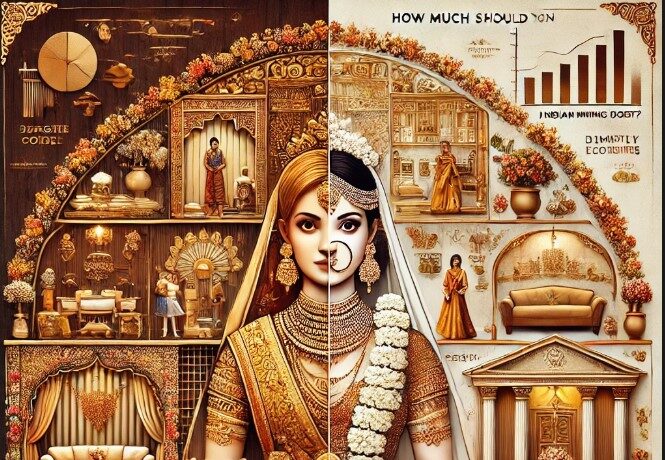The True Cost of Indian Weddings: A Generation in Crisis
The Price of Tradition: How Much Should a Wedding Cost?
In the U.S., weddings typically cost about two months’ salary. In Europe, the expectation stretches to six months’ earnings. But in India? The price of a wedding can consume 20 years’ worth of savings.
This stark financial reality underpins India’s $50 billion wedding industry, which is growing at an astonishing rate of 25% annually. Yet beneath the glamour and grandeur, a troubling consequence is emerging—one that is pushing an entire generation into financial and mental turmoil.
The Rising Burden: Financial Strain on Families
Every year, millions of Indian families spend a staggering 20% of their lifetime earnings on a single day—the wedding day. For middle-class families, this often means taking out loans averaging ₹4 lakhs ($4,800). Some even go as far as selling their assets or mortgaging their homes just to fund the ceremony.
This wasn’t always the case. In the 1990s, Indian weddings were primarily cultural celebrations, rooted in traditions and community bonding. Today, they have transformed into extravagant showcases of wealth, largely influenced by the rise of “Instagram weddings.”
The Influence of Social Media: The Birth of the ‘Big Fat Indian Wedding’
The past two decades have seen a dramatic shift in wedding expectations. Social media, particularly Instagram, has set an unattainable standard for celebrations, pressuring families to spend exorbitantly on:
- Designer bridal wear
- Destination venues
- Celebrity performances
- Lavish multi-day celebrations
However, the true cost of these extravagant weddings extends far beyond finances.
Mental Health Crisis: The Hidden Toll
A shocking 300% increase in wedding-related anxiety cases has been reported in India over the past decade. The statistics paint a grim picture: 
- 67% of individuals planning a wedding experience severe anxiety
- 42% report symptoms of depression
- 31% have suicidal thoughts directly linked to wedding preparations
The relentless pressure comes from multiple sources:
- Family expectations – Grand celebrations equated with family honor
- Societal judgment – Weddings seen as a status symbol
- Social media comparison – Perfectionism driven by online trends
- Peer pressure – Competitive spending among acquaintances
These factors create a perfect storm of mental health issues, leaving many struggling under the immense emotional weight of wedding planning.
A Personal Story: The Reality for Young Couples
Take the case of Priya (name changed), a 25-year-old software engineer from Delhi. Her family’s annual income is ₹8 lakhs ($9,200), yet the expected cost of her wedding is ₹25 lakhs ($29,000).
“The math doesn’t add up,” she says. “But society doesn’t care.”
The booming wedding loan industry exacerbates the issue:
- A 45% increase in wedding-related loans in just five years
- Rising loan default rates
- Young couples starting their married life already in debt
The Fight for Change: A New Generation’s Response
However, not everyone is bowing to tradition. Post-COVID, a new movement is gaining traction—one that prioritizes meaningful experiences over financial excess.
- Guest lists are shrinking from 500+ to 50-100 attendees
- More couples are opting for intimate, personal ceremonies
- Digital celebrations are becoming widely accepted
The results? Lower costs, reduced stress, and celebrations that genuinely reflect the couple’s values.
The Industry Pushback: The Battle to Maintain Extravagance
The wedding industry, however, is fighting back, with wedding planners, designers, and venue owners reinforcing traditional expectations:
- “It’s a once-in-a-lifetime event.”
- “What will people say?”
- “Think about family prestige.”
The resistance to change is strong, but experts propose a three-pronged solution:
- Policy Changes
- Capping wedding expenses
- Regulating wedding loans
- Providing tax benefits for smaller weddings
- Mental Health Support
- Pre-wedding counseling
- Family therapy sessions
- Community support groups
- Cultural Shift
- Promoting sustainable, minimalistic celebrations
- Challenging outdated societal pressures
- Prioritizing the well-being of the couple over public perception
A Future Beyond Extravagance
A growing number of young Indians are rejecting the pressure of grand weddings. Instead, they are choosing:
- Court marriages
- Intimate gatherings
- Charity donations over excessive spending
While the wedding industry continues to thrive, the real cost—both financial and emotional—is too high to ignore. As more couples take a stand, the question remains: Can India break free from the shackles of wedding extravagance and redefine its traditions for a healthier future?
Key Statements
Experts & Analysts:
- “Indian weddings have gone from cultural traditions to financial nightmares. The pressure to impress is crushing families.” – Financial Analyst Rohan Mehta
- “It’s heartbreaking to see couples start their married life in debt. A wedding is a celebration, not a financial burden.” – Mental Health Counselor Dr. Ananya Kapoor
Real Voices:
- “I wanted a simple wedding, but my parents said, ‘What will people say?’ So, I took a loan I’m still repaying.” – Rahul, 29, IT Professional
- “The stress of wedding planning gave me severe anxiety. It’s supposed to be the happiest day, not the most stressful one.” – Neha, 27, Bride-to-Be
- “Post-COVID, we chose a small, meaningful wedding. No regrets—just love and happiness.” – Akash & Priya, newlyweds
Q & A: Wedding Pressures in India
Q: Why do Indian families spend so much on weddings?
A: Weddings are seen as a status symbol. Society equates grand celebrations with family prestige, making it difficult to opt for a simple affair.
Q: How do social media and peer pressure influence weddings?
A: Instagram and Bollywood have glamorized weddings, creating unrealistic expectations. People feel compelled to match these extravagant standards, even if it means taking on debt.
Q: What’s the psychological impact of wedding pressures?
A: Studies show rising cases of wedding-related anxiety, depression, and even suicidal thoughts. The stress of meeting expectations takes a serious toll on mental health.
Q: What’s the alternative to an expensive wedding?
A: Couples are opting for intimate weddings with close family and friends, prioritizing experiences over extravagance. Court marriages, budget-friendly ceremonies, and charitable donations are gaining popularity.
Summary of Issues with Indian Weddings
- Financial Strain – Families take loans, mortgage homes, or sell assets for a single day’s event.
- Social Pressure – Families fear judgment and prioritize status over financial well-being.
- Mental Health Crisis – Anxiety, depression, and stress are common among couples and families.
- Wedding Loan Trap – The wedding loan industry is booming, with many couples starting their life in debt.
- Industry Influence – Wedding businesses push extravagant spending, making simple weddings seem “lesser.”
How a Simple Wedding Should Be
- Guest List: 50-100 people (close family & friends)
- Venue: Home, temple, court, or a budget-friendly location
- Attire: Comfortable, elegant, and affordable clothing
- Food: Quality over quantity—local, sustainable, and waste-free
- Rituals: Focus on meaningful traditions rather than showmanship
- Spending Priorities: Invest in the marriage, not just the wedding
Courtesy: Shawn Chauhan
![]()












nffzl7